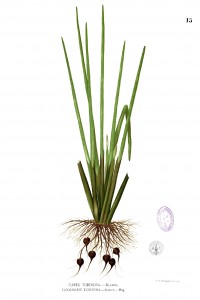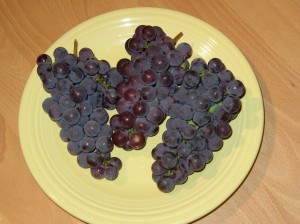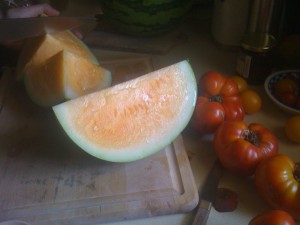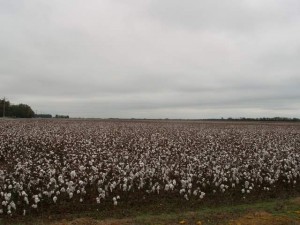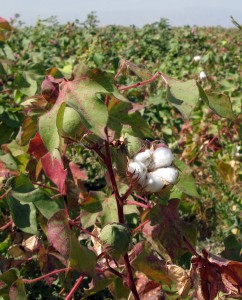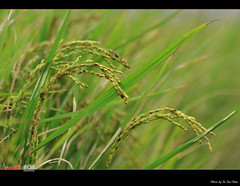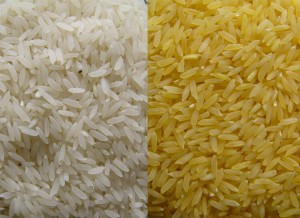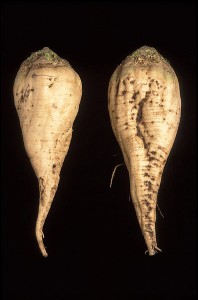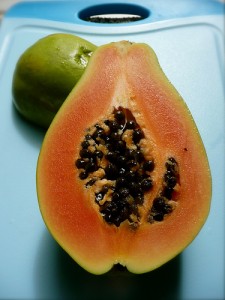Its tasty but what is it? First, a disclaimer. I’m going to be discussing traditional pumpernickel bread. The kind pictured to the right is almost certainly modern pumpernickel which gets its color from dark substances like molasses or cocoa powder, and often is made with wheat flower rather than the traditional rye. But that’s a boring story. This one is more exciting!
January 9, 2010
December 12, 2009
The Water Chestnut
The water chestnut is one of those foods I’ve eaten my whole life without knowing anything more about it than flavor and appearance (and that only because it so often shows up in frozen vegetable mixes).
The scientific name for the Water Chestnut is Eleocharis dulcis, and it’s often classified as a sedge.* It’s also a quite awesome plant. Consider:
- The visible parts of a water chestnut plant are leafless stems that perform photosynthesis. (The water chestnut has almost completely abandoned leaves!)
- The edible part of the plant is a botanical structure called a corm** which is a modified underground stem used by a plant to store energy (water chestnut plants are very much about stems). Not to be confused with bulbs like those of onions and garlic, which can look similar, but are instead made up mostly of leaves
- The reason water chestnuts remain so crunchy after cooking is that their cell walls are reinforced by special phenolic compounds, the same class of molecules as capsaicin, the molecule that makes chilli peppers spicy.
The genus Eleocharis also contains species like Eleocharis vivapara which switch between C3 and C4 forms of photosynthesis depending on whether they’re grown on dry land or in swamps. The relative advantages and costs of these two different forms of photosynthesis are worth a post on their own, but I’d always assumed it was an either/or choice and didn’t realize ANY plant species could pick to use whichever system was best suited to the local environment.[citation]
Domestication: (more…)
November 19, 2009
Not Genetically Engineered: Grapes
Scientific Name: Vitis vinifera
Supposed Genetically Engineered Trait: Large size/seedlessness
The Real Story:
Seedless grapes are descended from several different mutations that all result in the developing embryos of grape seeds to abort prematurely*. You can still find the tiny dead remnants of seeds in seedless grapes. Of course being seedless raises a new question: How do plant breeders work with seedless grapes? (more…)
November 17, 2009
Not Genetically Engineered: Watermelon
Scientific Name: Citrullus lanatus
Purported Genetically Engineered Trait: Lack of seeds
The Reality:
Seedless watermelons grow on triploid (three copies of every chromosome) watermelon plants. Like the banana, triploid watermelons are seedless because it’s impossible to separate three copies of each chromosome into different different reproductive cells. Unlike bananas, seedless watermelons are grown from seed and must be fertilized by fertile (diploid) watermelons to produce fruit.
Where do farmers get seeds for a seedless plant? (more…)
November 15, 2009
Genetically Engineered Crops: Cotton
Scientific Name: Gossypium itscomplicated*
Genetically Engineered Traits: Insect Resistance (bt), Herbicide Resistance
Details of Genetic Engineering:
Cotton has been genetically engineered to resist both glyphosate (by Monsanto) and glufinsate (by Bayer CropScience) under the names Roundup Ready and LibertyLink respectively. As I’ve discussed in previous posts, there are both economic and scientific advantages to having more than one herbicide/herbicide resistance system as it tends to keep prices down, and slows the development of resistant weeds when any resistance they evolve to one herbicide will be useless if the farmer switches to the other for the next growing season.
But the big deal when it comes to genetically engineered cotton is bt cotton that substantially reduces insect damage (and insecticide applications). In the US both Monsanto and Dow AgroSciences sell their own versions of bt cotton using different bt proteins with different specificities. The Chinese government has also developed and deployed their own bt cotton varieties. Bt cotton is the most widely grown** type of genetically engineered plant in the world today, grown in countries like China, India***, and Australia, where other genetically modified crops are not yet approved, for the obvious reason that it’s harder to get people upset about wearing “unnatural” things than eating them.****
About Cotton: (more…)
November 14, 2009
Genetically Engineered Crops: Rice
Scientific name: Orzya sativa
Genetically Engineered Traits: Herbicide tolerance, insect resistance (bt), increased vitamin A content
Details of Genetic Engineering:
Rice genetically engineered to be resistant to glufosinate (developed by Bayer CropScience) has been approved (deregulated) in the US but is not yet for sale commercially as the company attempts to get approval in countries which import rice from the US as well.
As far as I know, no company in the US has produced bt rice, which has less to do with consumer fears than with the small amount of rice production in the US rather than consumer rejection, but that’s just a guess. The Chinese government has developed breeds of bt rice, but doesn’t grow them commercially because of the risk to their export markets, which is primarily to countries that reject genetic engineering (although Chinese rice exports are declining drastically as more and more of their production is needed to feed their own people).
Golden rice, which has betacarotene, which human bodies need to make vitamin A, was developed by in Swizerland in the 1990s. Almost all plants produce carotenoids like betacarotene in their leaves as part of the biological machinery that makes photosynthesis possible. Breeders can sometimes identify and propogate natural mutations which lead to the expression of carotenoids in other parts of the plant, two key examples are orange carrots* and orange cauliflower. Vitamin A deficiency is a major issue** in many countries were rice is the primary crop, so breeders have searched for decades for natural mutations at would create orange rice, without success.*** The initial breed of golden rice which used two genes, one from daffodile to promote the expression of carotenoids in the grains of rice was attacked as requiring people to eat more than a dozen bowls of rice a day to get their daily recommended vitamin A intake, new versions that replaced the gene taken from daffodil with a version of the same gene taken from corn have more than twenty times as much beta carotene. Golden rice is also not currently grown commercially as it, like ringspot resistant papaya, doesn’t have a powerful for-profit corporation to shepherd it through the complex approval processes of various nations.
About Rice:
(more…)
November 13, 2009
Genetically Engineered Crops: Sugar Beet
Scientific Name: Beta vulgaris*
Genetically Engineered Trait: Herbicide resistance.
Details of Genetic Engineering:
Sugar beets tolerant of the herbicide glyphosate (created by Monsanto) were de-regulated by the USDA in 2005**. The beets were first grown commercially in 2008. Before the first seeds were even in the ground, the USDA was being sued in California for approving their cultivation. This fall (2009), a federal judge named Jeffery White ruled that the study of the environmental impacts of glyphosate tolerant beets (part of the data the USDA considered in its decision to deregulate the beets) should have considered the economic impacts of the herbicide tolerant beets on organic farmers. Since the ruling came at the end of the growing season,*** there was no time to breed new conventional seed to plant next spring. There may be enough seed next year, but if so it’ll be a stretch.
I’m keeping sugar beets on the list of genetically engineered crops, because there’s a still chance the plants will be grown next year. The judge still hasn’t decided if his own ruling should result in a ban on growing the beets. That’s all the detail I have room for here, but if you’re interested in the court case and the science behind it, I’d recommend checking out Anastasia’s excellent in depth follow up to the judge’s ruling.
About Sugar Beets: (more…)
November 12, 2009
Genetically Engineered Crops: Papaya
Scientific Name: Carica papaya
Genetically Engineered Trait: Resistance to the papaya ringspot virus
Details of Genetic Engineering:
In the 1990s papaya ringspot virus was in the process of wiping out the Hawaiian papaya industry, then the second largest fruit industry in Hawaii. Conventional approaches such as selective breeding for resistant papayas or attempting to grow trees in isolation had failed. The virus is transmitted by small sap-sucking insects such as aphids. Infected papaya trees can be recognized by the discolored rings on their fruit (that the virus gets its name from) yellow leaves, and most importantly from a papaya farmer’s perpsective a 60-100%* loss of fruit production. (more…)
November 11, 2009
Genetically Engineered Crop: Blue Carnations

Florigene's Moondust carnations, one of several violet and blue varieties they've created with genetic engineering. Photo by Pagemoral and licensed under the creative commons. Click to see the photo in its original context with license information
Scientific Name: Dianthus caryophyllus
Genetically Engineered Trait: Anthocyanin biosynthesis (blue and violet plant pigments)
Details of Genetic Engineering:
The market in flowers with genetically engineered colors is (to my knowledge) occupied by a single Australian company called Florigene. They study anthocyanins, the class of plant pigments responsible for, among other things, the coloration of purple potatoes, purple carrots, black rice, purple corn, and many blue and purple berries. Anthocyanins are one of the key classes of plant pigments, found to greater or lesser extent in most flowering plants.* Florigene has been producing purple and sometimes blue carnations since the 1990s by adding key enzymes in the anthocyanin pathway from other plant species. While purple carnations are cool, the real goal of Florigene’s work has been blue (and purple, and violet) roses, something rose breeders have been trying and failing to create for centuries.
Florigene was granted a license to grow their first breed of genetically engineered blue rose this summer, (although as far as I can tell the roses aren’t yet for sale, so they don’t get their own post). For more on plant pigments, Florigene, and why the development of blue roses as foiled breeders for so long, check out this fascinating post by MAT Kinase.
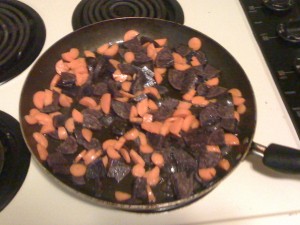
Purple potatoes with orange carrots (and did you know most carrots were white when they were first domesticated?)
About Carnations:
Carnations belong to the caryophyllales, an extended family of plants that include cacti (cool), rhubarb (tasty), and carnivorous plants like sundews and venus fly traps(awesome!). Beyond that, I’ll admit I don’t know much about their biology.
If you know someone who is into flower meanings (I used to date a girl who was), you’ll notice there is no definition on record for blue carnations. It makes them the perfect gift to say, “I like you, so I bought you flowers” without having to worry about any unintentional subtext beside: “I’m also a huge plant/genetics geek, and if you don’t ask me soon how they make the flowers blue I’m going to burst!”
*The extent of anthocyanin biosynthesis in flowering plants is a good indicator that the ancestor of all the flowering plants alive today (which lived sometime between 250 and 100 million years ago) already contained the genes needed to produce anthocyanins, and flowering plants which are unable to produce them today, like roses, cannot because their ancestors lost the ability.
November 10, 2009
Genetically Engineered Crops: Soybean
Scientific Name: Glycine max
Genetically Engineered Traits: Herbicide Resistance
Details of Genetic Engineering:
The genetic engineering of soybeans is pretty similar to that of Canola. Roundup Ready soybeans (produced by Monsanto) have been on the market for some time. The soybeans, which allowed farmers to spray an herbicide that kills all the plants in the field besides the soybeans themselves, have been a huge hit with market shares >90%. The benefit here is that being able to use herbicide resistant soybeans has been linked to increased use of no-till farming.* Bayer CropScience recently received regulatory approval for LibertyLink soybeans, their own herbicide + resistance system. Having another system is good for two reasons:
- Competition brings down prices for farmers
- Being able to rotate between two different herbicides prolongs the usefulness of both. Even if weeds develop some resistance to glyphosate (the active ingredient Roundup Ready crops are resistant to) the weeds are killed next year when the farmer sprays Glufosinate (the active ingredient that Liberty Link crops are resistant to).
About Soybeans: (more…)

